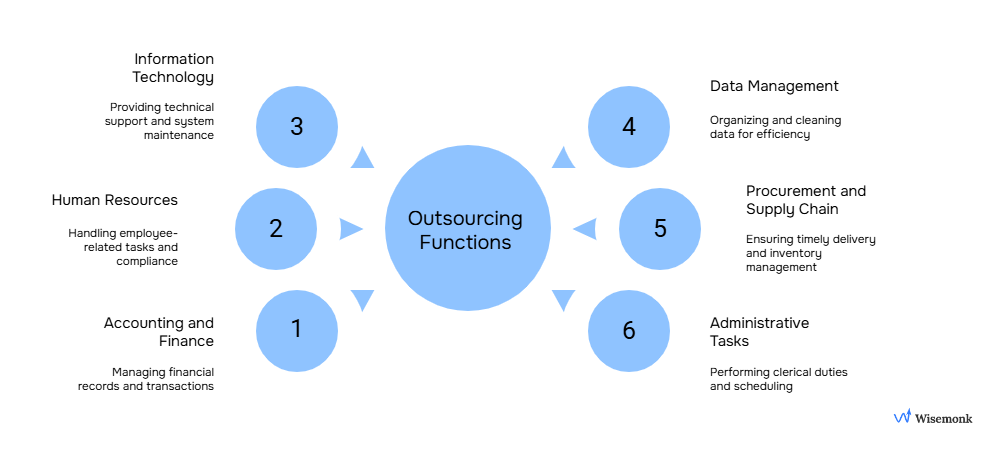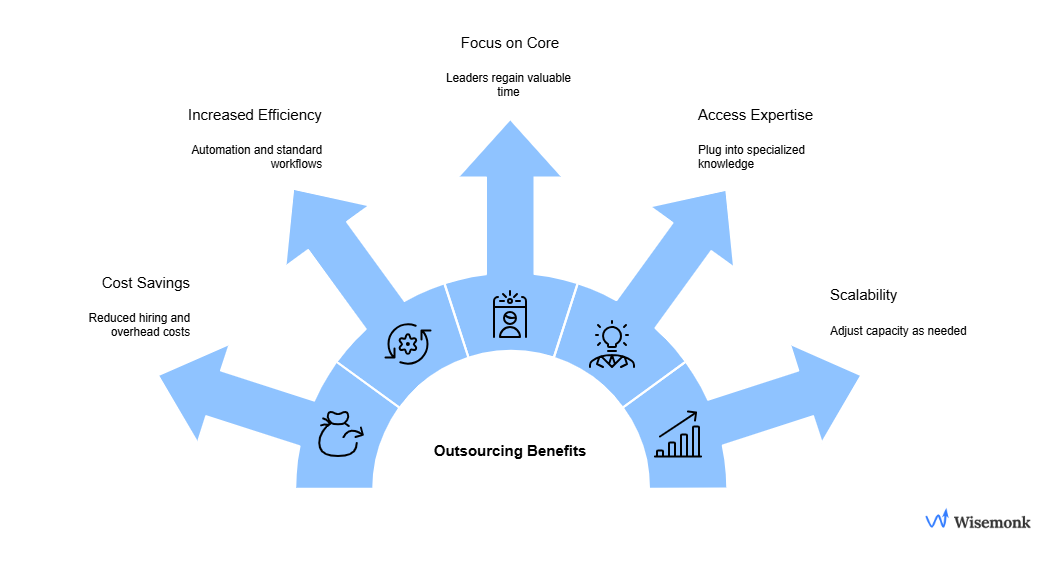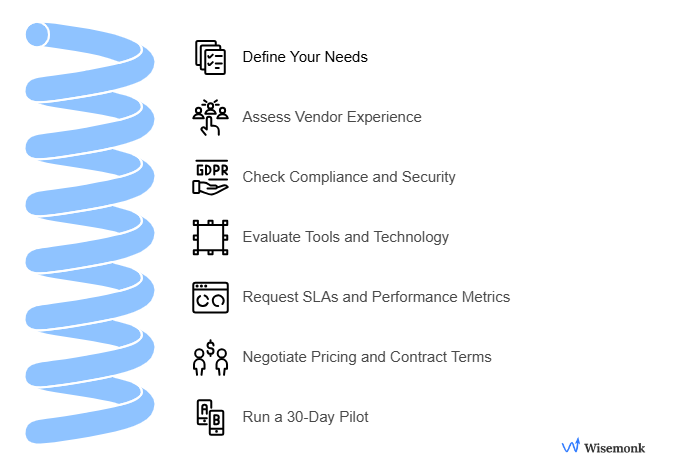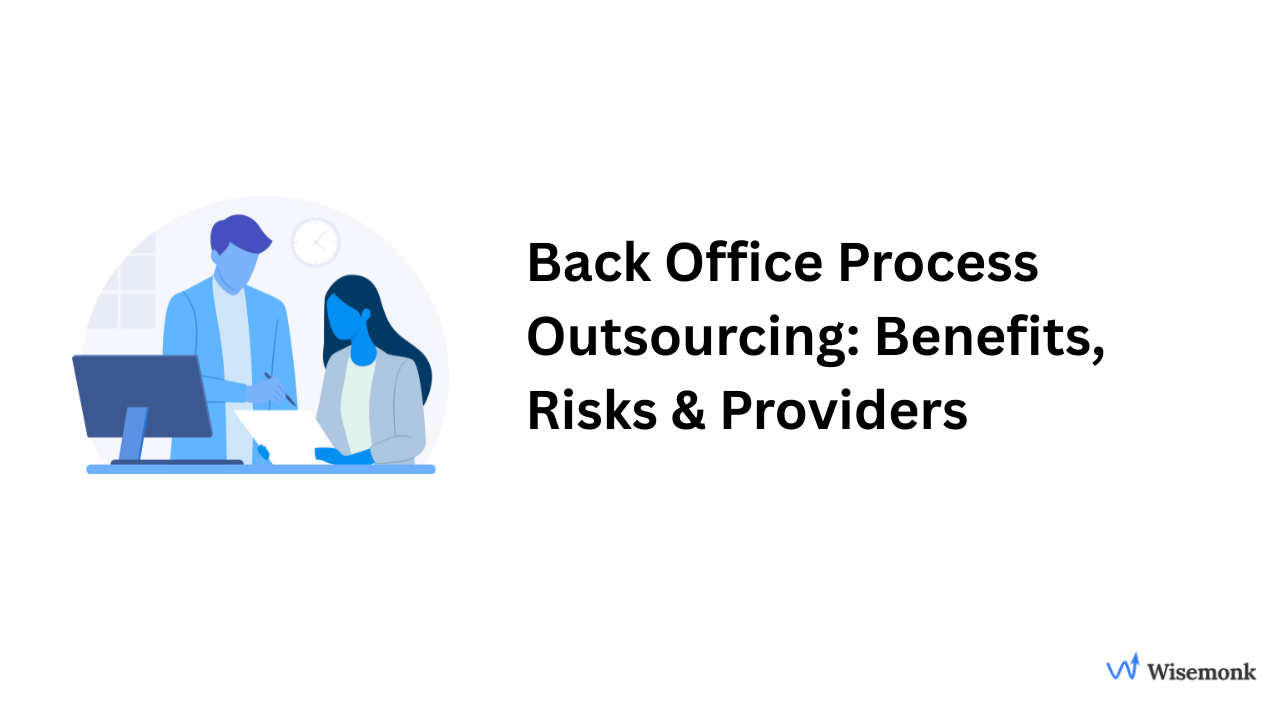- Backoffice outsourcing is a process of handing routine, non-customer-facing tasks like payroll, HR, IT, and data work to third-party providers. It helps companies cut costs and boost efficiency.
- The commonly outsourced back-office processes are finance (AP/AR, payroll, reporting), HR admin, IT support, data management, and procurement. These are repeatable tasks that don’t need direct customer interaction.
- The benefits of backoffice outsourcing are lower costs, faster cycle times, and more focus on core business priorities. Companies also gain access to expertise, scalable capacity, and compliance-ready systems.
- The best practices for back-office outsourcing are to define clear needs, vet vendors carefully, and set strong communication and security standards. Keep monitoring performance with KPIs and refine processes continuously for long-term success.
Ready to explore backoffice process outsourcing for your team? Contact us today!
Discover how Wisemonk creates impactful and reliable content.

Trying to find backoffice process outsourcing that clears your back-office backlog without losing control or compliance? You’re not alone; many US founders, HR leaders, and global teams hit capacity and need a reliable way to scale operations fast.
The goal of back office outsourcing is simple and involves delivering reliable, SLA-based execution of back-office tasks, reducing cycle times and errors, keeping compliance audit-ready, ensuring clean handoffs, and avoiding disruption to month-end close or hiring.
In this article, you’ll get what to outsource, how pricing and SLAs work, the real risks and controls so you can choose confidently and launch without drama; let’s dive in.
What exactly counts as “back office” today?[toc=Back-Office]
Back office is a set of processes that runs behind the scenes to keep a company operating. It’s non-customer-facing work across accounting, HR, IT, and operations, handling AP/AR, payroll, data and systems, compliance, and order fulfillment, so the client-facing “front office” can focus on sales and service.
What is back-office outsourcing?[toc=Back-Office Outsourcing]
Back-office outsourcing means letting a third party service provider do your behind-the-scenes work, like payroll, invoices, HR admin, and data tasks, so your team can focus on customers and growth.
Key characteristics
- Non-customer-facing work handled by a third-party partner.
- Focuses on routine, repeatable tasks like payroll, HR admin, accounting, data entry, and reporting.
- Runs on clear SOPs and measured through SLAs (accuracy, turnaround time, error rates).
- Allows businesses to scale capacity quickly without hiring full-time staff.
- Providers bring in specialized expertise and ready-to-use tools/tech.
Which back-office functions are commonly outsourced?[toc=Outsourced Functions]
With our extensive experience helping US companies run payroll, recruiting support, and compliance operations, here’s the short list of functions that consistently benefit from outsourcing.
- Accounting and Finance: Think bookkeeping, handling accounts payable and receivable, running payroll, and preparing financial statements.
- Human Resources (HR): Day-to-day admin like recruiting support, payroll processing, benefits management, keeping employee records straight, and staying compliant with labor laws.
- Information Technology (IT): Help desk support, troubleshooting, software updates, system upgrades, and keeping cybersecurity in check.
- Data Management: Repetitive but important tasks such as data entry, transcription, document imaging, and database cleanup.
- Procurement and Supply Chain: Managing vendors, keeping inventory flowing, processing orders, and making sure shipments arrive on time.
- Administrative Tasks: General clerical work, virtual assistance, managing inboxes, and scheduling meetings.
Want a deeper dive into payroll and compliance outsourcing? Check our article on "Payroll Outsourcing: All You Need to Know".
Why do companies switch to back-office outsourcing services?[toc=Why Companies Switch]

Drawing on our work helping companies with payroll solutions, worker classification, and compliance filings, the benefits we see most often are speed, audit-readiness, and true follow-the-sun support.
- Cost Savings: Cut hiring, training, benefits, and office/tool costs by moving routine work to a specialist. You shift fixed headcount and capex into predictable per-FTE or per-transaction fees. That frees budget for product and growth instead of overhead.
- Increased Efficiency: Specialist teams run SOPs and QA from day one, so rework drops immediately. Automation (RPA/OCR) and standard workflows shrink cycle times and backlog. With SLAs and dashboards in place, bottlenecks surface fast and get fixed.
- Focus on Core Business: Offload admin so leaders and ICs get hours back each week. You keep approvals and visibility while the busywork moves off your plate. The result is faster shipping, cleaner pipeline, and better customer outcomes.
- Access to Expertise: Plug into payroll, compliance, finance ops, and data pros you don’t have in-house. They already know your HRIS/ERP and country rules, so ramp time is minimal. You get proven runbooks and audit discipline instead of reinventing processes.
- Scalability & Flexibility: Add capacity for peaks or new markets and dial down when volumes dip. Time-zone coverage comes without new offices or org rewires. Scope adjusts in weeks, not quarters, so there’s no hiring spree or layoffs.
That’s why most growing companies turn to back-office outsourcing, not just to save money, but to buy back time, expertise, and peace of mind.
What are the risks of back-office outsourcing?[toc=Risks & Challenges]
With deep experience supporting US and global businesses across payroll, hiring, and compliance, we’ve learned the hard lessons,
Here are the real risks of back office outsourcing:
- Data security breaches: Sensitive payroll and employee data can be mishandled if controls are weak. Mitigation: demand role-based access, encryption, and regular audits from your provider.
- Compliance mistakes: Wrong filings or misclassification can create penalties and legal risk. Mitigation: choose vendors with proven compliance runbooks and request sample filings before signing.
- Loss of process control: Outsourcing without clear SOPs can lead to errors and rework. Mitigation: document processes upfront, set SLAs, and run parallel tests before go-live.
- Hidden costs: Training, shadow systems, or unexpected fees can erode savings. Mitigation: insist on transparent pricing and clarify scope in the contract.
- Vendor dependence: Relying on one provider can be risky if service quality drops. Mitigation: build exit clauses, retain core knowledge in-house, and monitor KPIs regularly.
- Quality drift over time: Standards can slip once the contract is running. Mitigation: hold quarterly business reviews (QBRs), track KPIs, and enforce corrective actions early.
Pro tip: Always ask your outsourcing provider for a sample compliance filing or audit report before you sign. It’s the quickest way to see if their “controls” actually work in practice.
What are the best practices for successful back-office outsourcing?[toc=Best Practices]
With years spent helping US companies stand up payroll, recruiting support, and compliance workflows, we’ve distilled the habits that keep engagements on track.
- Clearly define your needs – Before you even start talking to providers, list the processes you want to outsource and the KPIs you’ll use to measure success.
- Vet vendors carefully – Don’t just take their website at face value. Look into their track record, client reviews, security standards, and real experience with businesses like yours.
- Prioritize communication – Set up a clear communication rhythm from day one. Use collaboration tools, agree on response times, and schedule regular check-ins to stay aligned.
- Ensure data security – Your contract should spell out data security and confidentiality obligations. Always choose providers who comply with regulations like GDPR or HIPAA.
- Optimize and monitor continuously – Outsourcing isn’t “set and forget.” Keep tracking performance against KPIs, share feedback often, and refine processes to keep things running smoothly.
Curious how outsourcing actually drives savings? Check out our detailed article on "Back Office Cost Saving Through Outsourcing".
What is the step-by-step process of back-office outsourcing?[toc=Steps to Outsource]
With our practical experience helping global businesses launch payroll, hiring support, and compliance operations, here’s the plain-English sequence that actually works.
Here’s a clear breakdown of the step-by-step journey of back-office outsourcing:
Step 1: Identify the right tasks: Start by picking the routine, rules-based processes, things like payroll runs, AP/AR, or data entry, that eat up time but don’t need your core team’s brainpower.
Step 2: Choose a provider you can trust: Not all vendors are equal. Look for one with proven expertise in payroll, HR, or compliance, and check how they handle security, data privacy, and SLAs.
Step 3: Set clear expectations: Agree upfront on SOPs, SLAs, and KPIs. For example, error rates, turnaround times, or backlog size, whatever matters most to your business.
Step 4: Transition gradually: Don’t flip the switch overnight. Run a short parallel phase where both your team and the provider process the same tasks. Compare outputs, fix gaps, and build confidence.
Step 5: Go live with oversight: Once you’re comfortable, hand over full execution. The provider now owns the day-to-day, while your team keeps final approvals and governance.
Step 6: Keep tracking and improving: Outsourcing isn’t a “set and forget.” Review reports, hold regular check-ins, and use data to tighten processes or introduce automation over time.
In the end, outsourcing works best when it’s treated as a living process, not a one-time project, the real gains come from continuous tuning and partnership.
How does back-office BPO differ from front-office BPO and shared services?[toc=Back vs. Front office vs. Shared]
From advising global teams on payroll/HR outsourcing versus EOR builds or captive hubs, we’ve mapped the differences that actually change outcomes.
Fact: Four years ago, 70% of organizations cited cost savings as the main reason for outsourcing.”-Deloitte Global Outsourcing Survey 2024
What are the types of outsourcing locations for back-office work?[toc=Types of Outsourcing]
Given our experience running payroll and HR operations across geographies under strict compliance, here’s how we match location models to workload sensitivity and collaboration needs.
Pro tip: Offshore may look cheapest on paper, but always weigh compliance maturity and time-zone overlap before locking in a delivery model.
What are the mistakes to avoid in back-office outsourcing?[toc=Mistakes to Avoid]
Back office outsourcing services can deliver significant cost savings and better operational efficiency, but only if companies avoid common pitfalls. Many failures in business process outsourcing don’t come from the outsourcing partner, but from weak planning and oversight.
Here are the mistakes to avoid in outsourcing back office functions:
- Outsourcing broken processes: Sending messy or undocumented workflows to a vendor only multiplies errors. Fix: clean and document processes before handing them over.
- No clear SLAs or KPIs: Vague expectations lead to disputes and poor quality. Fix: set measurable targets like accuracy %, cycle time, backlog, and on-time filings.
- Ignoring compliance requirements: Misclassification, payroll leaks, or data mishandling can trigger penalties. Fix: choose vendors with compliance expertise and demand evidence of controls.
- Over-customizing reports: Endless bespoke formats slow things down. Fix: agree on standard dashboards, then add exceptions only when needed.
- Vendor lock-in without exit plan: Relying on one provider leaves you exposed if quality drops. Fix: include exit clauses and retain knowledge internally.
- Weak governance after go-live: Letting quality drift unchecked erodes trust. Fix: run regular reviews, track KPIs, and enforce corrective actions early
Most outsourcing failures don’t come from the back office outsourcing companies themselves, but from poor governance. Treat your provider like a partner, not a vendor, and you’ll avoid costly mistakes.
Who are the top back-office outsourcing providers?[toc=Top Back-Office Providers]
With our ongoing work helping US companies evaluate payroll, HR, and compliance partners, we keep a practical shortlist, here are notable names and what to weigh.
1. TECHSPEED INC (U.S.)
A U.S.-based BPO specializing in back-office services, known for a high-touch approach, responsiveness, and deep experience in remote back-office and admin outsourcing.
2. Digital Minds BPO (Philippines / global)
A Philippines-headquartered BPO that offers both back-office and front-office services, focused on cost efficiency and scalability for small to mid-sized companies. Known for taking on repetitive, process-intensive tasks.
3. Unity Communications (U.S. / global)
A hybrid provider that offers back-office and related BPO services with delivery centers across the U.S., Mexico, Philippines, and India. Seen as a credible bridge between cost savings and proximity.
4. Quality Back Office (U.S.)
A U.S.-based provider focusing on accounting, payroll, invoicing, and bookkeeping with over 10 years of experience. Lists itself as a “top U.S. back-office services” firm.
5. Hugo (U.S.)
Chicago-based firm offering back-office, catalog, claims processing, and transaction support services. Known for its compliance orientation and partnerships with tech/marketplace companies.
Curious which HR outsourcing company fits your needs? Check out our deep dive on "Top HR Outsourcing Companies in India".
How to choose the right back-office outsourcing provider?[toc=How to Choose]

With our experience helping global businesses stand up payroll, recruiting support, and compliance operations, we use this quick selection flow so teams don’t miss the critical checks.
- Define your needs: Identify which back-office tasks you want to outsource (e.g., payroll, HR, data management) and set clear expectations for accuracy, turnaround, and compliance.
- Assess vendor experience: Look for providers with expertise in your specific industry and processes (payroll, HRIS, finance, etc.). Their experience in similar companies or workloads will ensure smoother onboarding.
- Check compliance and security: Ensure the provider understands and can meet all legal and regulatory requirements in your country or region (e.g., GDPR, tax filings). Ask for proof of compliance processes and security certifications.
- Evaluate tools and technology: Make sure the provider uses up-to-date software that integrates well with your current systems (ERP, HRIS, etc.) to ensure seamless workflows and data management.
- Request SLAs and performance metrics: Demand clear Service Level Agreements (SLAs) and KPIs to measure performance, including turnaround times, accuracy, and error rates.
- Negotiate pricing and contract terms
Ensure transparency in pricing models (per-FTE, per-output) and negotiate clear contract terms, including exit clauses, to avoid future surprises.
Pro tip: Before you sign, run a 30-day pilot with parallel processing, it’s the fastest way to see how a provider handles accuracy, security, and exceptions in real conditions.
What SLAs and KPIs actually predict success?[toc=SLAs & KPI]
With our experience running payroll, compliance, and HR operations across borders, we’ve seen which metrics matter for long-term outcomes and which just look good on a slide deck.
Quality metrics: first-pass yield, error severity index
- First-pass yield (FPY): % of transactions processed correctly on the first attempt, high FPY means fewer costly reworks.
- Error severity index: Tracks not just errors but their business impact (a misfiled tax return ≠ a typo on an internal form).
Speed metrics: AHT, TAT by queue, aged backlog
- Average Handle Time (AHT): Useful for standard tasks, but only when balanced with accuracy.
- Turnaround Time (TAT): Track by queue (payroll, invoices, onboarding) instead of overall averages.
- Aged backlog: The volume of tasks pending beyond SLA, a sharper indicator of systemic issues.
Control metrics: audit findings, access reviews, exception rate
- Audit findings: Measure both frequency and severity of issues raised in internal/external audits.
- Access reviews: Track compliance with role-based access controls (RBAC).
- Exception rate: % of tasks needing manual intervention, a leading indicator for automation opportunities.
Quarterly Business Review (QBR) template
A sample QBR should cover:
- SLA performance summary (with FPY, TAT, backlog).
- Compliance/audit results.
- Root cause analysis of exceptions.
- Process improvement roadmap (automation, training, tooling).
Fact: According to Deloitte’s Global Outsourcing Survey 2024, 80% of BPO contracts now include SLA-based penalties or incentives, sign that metrics are no longer optional.
How do leading providers package back-office services in practice?[toc=Leading Providers Package]
Supporting US companies with payroll, HR, and compliance outsourcing, we see providers rarely sell “one task at a time”, they package services into desks and tool coverage to scale smoothly.
Typical bundles: Finance Ops Desk, People Ops Desk, Data Ops Desk
- Finance Ops Desk: AP/AR, payroll runs, reconciliations, financial reporting.
- People Ops Desk: Onboarding, benefits admin, payroll support, HR compliance.
- Data Ops Desk: Data entry, cleansing, reporting, document imaging.
Tool coverage: ERPs, HRIS, ticketing, RPA, OCR, ETL
- Providers typically plug into your ERP (NetSuite, SAP), HRIS (Workday, BambooHR), ticketing systems (Zendesk, Jira), and add automation with RPA/OCR for repetitive workflows or ETL tools for data pipelines.
Onshore/nearshore/offshore hybrids and when to use them
- Onshore: For compliance-heavy finance/HR tasks.
- Nearshore: For real-time collaboration on people ops.
- Offshore: For high-volume, rules-based data and finance ops.
- Many providers mix these into a follow-the-sun delivery model.
Sample RFP scope blocks you can copy
When drafting your RFP, include blocks like:
- Finance Ops: Payroll cycle execution, AP/AR turnaround, compliance filings.
- People Ops: Employee data management, benefits admin, onboarding SLAs.
- Data Ops: Document processing volumes, accuracy targets, exception handling.
Bundled desks and hybrid delivery models don’t just simplify vendor management, they make scaling smoother when your workloads spike.
How can Wisemonk support your back-office outsourcing needs?[toc=How Wisemonk Helps]
Wisemonk is a leading Employer of Record in India that helps global companies hire, pay, and manage talent with ease. Here’s how we add value:
- Employer of Record (EOR) services : Hire full-time employees in India without setting up an entity, while staying compliant with labor codes.
- Payroll and compliance execution : We run accurate payroll cycles, manage PF/ESI/TDS filings, and keep you audit-ready.
- Contractor vs. employee classification : Avoid misclassification risks with clear AOR/EOR support.
- Equipment provisioning: Ensure remote hires have the tools and hardware they need from day one.
- Scalable HR operations: From onboarding to ongoing HR admin, we help you expand capacity without building in-house overhead.
Book a free consultation to explore compliant, hassle-free hiring in India.




.webp)

